Long-Term Variability of Phytoplankton Size Classes in the Littoral Seas of Korea Using Deep Neural Networks and Satellite Data
Abstract
1. Introduction
2. Materials and Methods
2.1. DNN-Based Classification for Dominant PSCs in the Littoral Seas of Korea
2.2. Satellite Data Collection
2.3. In-Situ Nutrients Data
2.4. Statistical Analyses
3. Results
3.1. Spatial–Temporal Distributions of the Dominant PSCs in the Littoral Seas of Korea
3.2. Long-Term Trends of the PSCs in the Littoral Seas of Korea
3.3. Relationships Between Environmental Parameters and the PSCs in the Littoral Seas of Korea
4. Discussion
4.1. Spatial and Seasonal Variability of Dominant PSCs in the Littoral Seas of Korea
4.2. Long-Term Expansion in Pico-Size Phytoplankton Dominance and Their Ecological Implications
4.2.1. Temporal Patterns of Pico-Size Phytoplankton Dominance
4.2.2. Spatial Expansion of Pico-Size Phytoplankton Dominance
4.2.3. Potential Ecological Effects of Pico-Size Phytoplankton Expansion
5. Summary and Conclusions
Supplementary Materials
Author Contributions
Funding
Data Availability Statement
Acknowledgments
Conflicts of Interest
References
- Falkowski, P.G.; Fenchel, T.; Delong, E.F. The microbial engines that drive Earth’s biogeochemical cycles. Science 2008, 320, 1034–1039. [Google Scholar] [CrossRef] [PubMed]
- Uitz, J.; Claustre, H.; Gentili, B.; Stramski, D. Phytoplankton class-specific primary production in the world’s oceans: Seasonal and interannual variability from satellite observations. Glob. Biogeochem. Cycles 2010, 24, GB3016. [Google Scholar] [CrossRef]
- Litchman, E.; Edwards, K.F.; Klausmeier, C.A.; Thomas, M.K. Phytoplankton niches, traits and eco-evolutionary responses to global environmental change. Mar. Ecol. Prog. Ser. 2012, 470, 235–248. [Google Scholar] [CrossRef]
- Henson, S.A.; Cael, B.B.; Allen, S.R.; Dutkiewicz, S. Future phytoplankton diversity in a changing climate. Nat. Commun. 2021, 12, 5372. [Google Scholar] [CrossRef]
- Finkel, Z.V.; Beardall, J.; Flynn, K.J.; Quigg, A.; Rees, T.A.V.; Raven, J.A. Phytoplankton in a changing world: Cell size and elemental stoichiometry. J. Plankton Res. 2010, 32, 119–137. [Google Scholar] [CrossRef]
- Agustí, S.; González-Gordillo, J.I.; Vaqué, D.; Estrada, M.; Cerezo, M.I.; Salazar, G.; Gasol, J.M.; Duarte, C.M. Ubiquitous healthy diatoms in the deep sea confirm deep carbon injection by the biological pump. Nat. Commun. 2015, 6, 7608. [Google Scholar] [CrossRef]
- Cavan, E.L.; Laurenceau-Cornec, E.C.; Bressac, M.; Boyd, P.W. Exploring the ecology of the mesopelagic biological pump. Prog. Oceanogr. 2019, 176, 102125. [Google Scholar] [CrossRef]
- Tréguer, P.; Bowler, C.; Moriceau, B.; Dutkiewicz, S.; Gehlen, M.; Aumont, O.; Bittner, L.; Dugdale, R.C.; Finkel, Z.; Iudicone, D.; et al. Influence of diatom diversity on the ocean biological carbon pump. Nat. Geosci. 2018, 11, 27–37. [Google Scholar] [CrossRef]
- Huete-Ortega, M.; Calvo-Díaz, A.; Graña, R.; Mouriño-Carballido, B.; Marañón, E. Effect of environmental forcing on the biomass, production and growth rate of size-fractionated phytoplankton in the central Atlantic Ocean. J. Mar. Syst. 2011, 88, 203–213. [Google Scholar] [CrossRef]
- Morán, X.A.G.; Scharek, R. Photosynthetic parameters and primary production, with focus on large phytoplankton, in a temperate mid-shelf ecosystem. Estuar. Coast. Shelf Sci. 2015, 154, 255–263. [Google Scholar] [CrossRef]
- Uitz, J.; Huot, Y.; Bruyant, F.; Babin, M.; Claustre, H. Relating phytoplankton photophysiological properties to community structure on large scales. Limnol. Oceanogr. 2008, 53, 614–630. [Google Scholar] [CrossRef]
- Lee, S.H.; Ryu, J.; Lee, D.; Park, J.-W.; Kwon, J.-I.; Zhao, J.; Son, S. Spatial variations of small phytoplankton contributions in the Northern Bering Sea and the Southern Chukchi Sea. GISci. Remote Sens. 2019, 56, 794–810. [Google Scholar] [CrossRef]
- Mena, C.; Reglero, P.; Hidalgo, M.; Sintes, E.; Santiago, R.; Martín, M.; Moyà, G.; Balbín, R. Phytoplankton community structure is driven by stratification in the oligotrophic Mediterranean Sea. Front. Microbiol. 2019, 10, 1698. [Google Scholar] [CrossRef] [PubMed]
- Zhan, W.; Feng, M.; Zhang, Y.; Shen, X.; Zhan, H.; He, Q. Reduced and smaller phytoplankton during marine heatwaves in eastern boundary upwelling systems. Commun. Earth Environ. 2024, 5, 629. [Google Scholar] [CrossRef]
- Lee, S.H.; Yun, M.S.; Kim, B.K.; Joo, H.; Kang, S.H.; Kang, C.K.; Whitledge, T.E. Contribution of small phytoplankton to total primary production in the Chukchi Sea. Cont. Shelf Res. 2013, 68, 43–50. [Google Scholar] [CrossRef]
- Morán, X.A.G.; López-Urrutia, Á.; Calvo-Díaz, A.; Li, W.K.W. Increasing importance of small phytoplankton in a warmer ocean. Glob. Change Biol. 2010, 16, 1137–1144. [Google Scholar] [CrossRef]
- Sieburth, J.M.N.; Smetacek, V.; Lenz, J. Pelagic ecosystem structure: Heterotrophic compartments of the plankton and their relationship to plankton size fractions. Limnol. Oceanogr. 1978, 23, 1256–1263. [Google Scholar] [CrossRef]
- Joo, H.; Son, S.; Park, J.W.; Kang, J.J.; Jeong, J.Y.; Kwon, J.I.; Kim, C.-K.; Lee, S.H. Small phytoplankton contribution to the total primary production in the highly productive Ulleung Basin in the East/Japan Sea. Deep Sea Res. Part II Top. Stud. Oceanogr. 2017, 143, 54–61. [Google Scholar] [CrossRef]
- Son, S.; Kim, Y.; Kwon, J.; Kim, H.; Park, K. Characterization of spatial and temporal variation of suspended sediments in the Yellow and East China Seas using satellite ocean color data. GISci. Remote Sens. 2014, 51, 212–226. [Google Scholar] [CrossRef]
- Brewin, R.J.W.; Sathyendranath, S.; Hirata, T.; Lavender, S.J.; Barciela, R.M.; Hardman-Mountford, N.J. A three-component model of phytoplankton size class for the Atlantic Ocean. Ecol. Model. 2010, 221, 1472–1483. [Google Scholar] [CrossRef]
- Hirata, T.; Aiken, J.; Hardman-Mountford, N.; Smyth, T.; Barlow, R. An absorption model to determine phytoplankton size classes from satellite ocean colour. Remote Sens. Environ. 2008, 112, 3153–3169. [Google Scholar] [CrossRef]
- Mouw, C.B.; Hardman-Mountford, N.J.; Alvain, S.; Bracher, A.; Brewin, R.J.W.; Bricaud, A.; Ciotti, A.M.; Devred, E.; Fujiwara, A.; Hirata, T.; et al. A consumer’s guide to satellite remote sensing of multiple phytoplankton groups in the global ocean. Front. Mar. Sci. 2017, 4, 41. [Google Scholar] [CrossRef]
- Uitz, J.; Claustre, H.; Morel, A.; Hooker, S.B. Vertical distribution of phytoplankton communities in open ocean: An assessment based on surface chlorophyll. J. Geophys. Res. Oceans 2006, 111, C08005. [Google Scholar] [CrossRef]
- Hirata, T.; Hardman-Mountford, N.J.; Brewin, R.J.W.; Aiken, J.; Barlow, R.; Suzuki, K.; Isada, T.; Howell, E.; Hashioka, T.; Noguchi-Aita, M.; et al. Synoptic relationships between surface Chlorophyll-a and diagnostic pigments specific to phytoplankton functional types. Biogeosciences 2011, 8, 311–327. [Google Scholar] [CrossRef]
- Liu, H.; Liu, X.; Xiao, W.; Laws, E.A.; Huang, B. Spatial and temporal variations of satellite-derived phytoplankton size classes using a three-component model bridged with temperature in marginal seas of the western Pacific Ocean. Prog. Oceanogr. 2021, 191, 102511. [Google Scholar] [CrossRef]
- Sun, D.; Huan, Y.; Wang, S.; Qiu, Z.; Ling, Z.; Mao, Z.; He, Y. Remote sensing of spatial and temporal patterns of phytoplankton assemblages in the Bohai Sea, Yellow Sea, and East China Sea. Water Res. 2019, 157, 119–133. [Google Scholar] [CrossRef]
- Kang, J.J.; Oh, H.J.; Youn, S.H.; Park, Y.; Kim, E.; Joo, H.T.; Hwang, J.D. Estimation of phytoplankton size classes in the littoral sea of Korea using a new algorithm based on deep learning. J. Mar. Sci. Eng. 2022, 10, 1450. [Google Scholar] [CrossRef]
- Ye, H.; Tang, D. A three-component model of phytoplankton size classes for the South China Sea. Malays. J. Sci. 2013, 32, 325–332. [Google Scholar]
- Fei, X.; Zhang, Y.; Qiao, X.; Song, Z.; Wang, H.; Hu, J.; Liu, X.; Guo, C.; Liu, S.M. Changjiang River–sourced nutrients support massive biological carbon fixation in the East China Sea. Nat. Commun. 2024, 15, 1991. [Google Scholar]
- Joo, H.T.; Park, J.W.; Son, S.; Noh, J.-H.; Jeong, J.-Y.; Kwak, J.H.; Saux-Picart, S.; Choi, J.H.; Kang, C.-K.; Lee, S.H. Long-term annual primary production in the Ulleung Basin as a biological hot spot in the East/Japan Sea. J. Geophys. Res. Oceans 2014, 119, 3002–3011. [Google Scholar] [CrossRef]
- Lin, C.; Ning, X.; Su, J.; Lin, Y.; Xu, B. Environmental changes and the responses of the ecosystems of the Yellow Sea during 1976–2000. J. Mar. Syst. 2005, 55, 223–234. [Google Scholar] [CrossRef]
- Han, I.-S.; Lee, J.-S.; Jung, H.-K. Long-term pattern changes of sea surface temperature during summer and winter due to climate change in the Korea Waters. Fish. Aquat. Sci. 2023, 26, 639–648. [Google Scholar] [CrossRef]
- Jin, J.; Liu, S.M.; Ren, J.L.; Liu, C.G.; Zhang, J.; Zhang, G.L.; Huang, D.J. Nutrient dynamics and coupling with phytoplankton species composition during the spring blooms in the Yellow Sea. Deep Sea Res. Part II Top. Stud. Oceanogr. 2013, 97, 16–32. [Google Scholar] [CrossRef]
- Lee, E.-Y.; Park, K.-A. Change in the recent warming trend of sea surface temperature in the East Sea (Sea of Japan) over decades (1982–2018). Remote Sens. 2019, 11, 2613. [Google Scholar] [CrossRef]
- Jang, H.K.; Kang, J.J.; Lee, J.H.; Kim, M.; Ahn, S.H.; Jeong, J.Y.; Yun, M.S.; Han, I.S.; Lee, S.H. Recent primary production and small phytoplankton contribution in the Yellow Sea during the summer in 2016. Ocean Sci. J. 2018, 53, 509–519. [Google Scholar] [CrossRef]
- Jang, H.-K.; Youn, S.-H.; Joo, H.; Kim, Y.; Kang, J.-J.; Lee, D.; Jo, N.; Kim, K.; Kim, M.-J.; Kim, S.; et al. First concurrent measurement of primary production in the Yellow Sea, the South Sea of Korea, and the East/Japan Sea, 2018. J. Mar. Sci. Eng. 2021, 9, 1237. [Google Scholar] [CrossRef]
- Kang, J.J.; Jang, H.K.; Lim, J.H.; Lee, D.; Lee, J.H.; Bae, H.; Lee, C.H.; Kang, C.K.; Lee, S.H. Characteristics of different size phytoplankton for primary production and biochemical compositions in the Western East/Japan Sea. Front. Microbiol. 2020, 11, 560102. [Google Scholar] [CrossRef]
- Kim, Y.; Youn, S.-H.; Oh, H.-J.; Joo, H.; Jang, H.-K.; Kang, J.-J.; Lee, D.; Jo, N.; Kim, K.; Park, S.; et al. Seasonal compositions of size-fractionated surface phytoplankton communities in the Yellow Sea. J. Mar. Sci. Eng. 2022, 10, 1087. [Google Scholar] [CrossRef]
- Lee, D.; Kang, J.J.; Jo, N.; Kim, K.; Jang, H.K.; Kim, M.J.; Kim, Y.; Park, S.; Son, S.; Kwon, J.I.; et al. Variations in phytoplankton primary production driven by the Pacific Decadal Oscillation in the East/Japan Sea. J. Geophys. Res. Biogeosci. 2022, 127, e2022JG007094. [Google Scholar] [CrossRef]
- Lee, D.; Lee, D.H.; Joo, H.; Jang, H.K.; Park, S.; Kim, Y.; Kim, S.; Kim, J.; Kim, M.; Kwon, J.I.; et al. Long-term variability of phytoplankton primary production in the Ulleung Basin, East Sea/Japan Sea using ocean color remote sensing. J. Geophys. Res. Oceans 2024, 129, e2024JC020898. [Google Scholar] [CrossRef]
- Park, K.A.; Park, J.J.; Park, J.E.; Choi, B.J.; Lee, S.H.; Byun, D.S.; Lee, E.L.; Kang, B.S.; Shin, H.R.; Lee, S.R. Interdisciplinary mathematics and sciences in schematic ocean current maps in the seas around Korea. In Handbook of the Mathematics of the Arts and Sciences; Springer International Publishing: Cham, Switzerland, 2021; pp. 2359–2388. [Google Scholar]
- Moon, J.-E.; Ahn, Y.-H.; Ryu, J.-H.; Palanisamy, S. Development of ocean environmental algorithms for Geostationary Ocean Color Imager. Korean J. Remote Sens. 2010, 26, 198–207. [Google Scholar]
- Dunstan, P.K.; Foster, S.D.; King, E.; Risbey, J.; O’Kane, T.J.; Monselesan, D.; Hobday, A.J.; Hartog, J.R.; Thompson, P.A. Global patterns of change and variation in sea surface temperature and chlorophyll a. Sci. Rep. 2018, 8, 14624. [Google Scholar] [CrossRef] [PubMed]
- Sun, Y.; Youn, S.-H.; Oh, H.J.; Joo, H.-T.; Kim, Y.; Kang, J.J.; Lee, D.; Kim, K.; Jang, H.K.; Jo, N.; et al. Spatial and temporal distribution of phytoplankton community in relation to environmental factors in the southern coastal waters of Korea. Front. Mar. Sci. 2022, 9, 950234. [Google Scholar] [CrossRef]
- Wood, S.; Wood, M.S. Package ‘mgcv’; R Package Version; R Foundation for Statistical Computing: Vienna, Austria, 2015; Volume 1, p. 729. [Google Scholar]
- Domingues, R.B.; Anselmo, T.P.; Barbosa, A.B.; Sommer, U.; Galvão, H.M. Light as a driver of phytoplankton growth and production in the freshwater tidal zone of a turbid estuary. Estuar. Coast. Shelf Sci. 2011, 91, 526–535. [Google Scholar] [CrossRef]
- Riegman, R.; Noordeloos, A.A.M. Size-fractionated uptake of nitrogenous nutrients and carbon by phytoplankton in the North Sea during summer 1994. Mar. Ecol. Prog. Ser. 1998, 173, 85–96. [Google Scholar] [CrossRef][Green Version]
- Ramakrishnan, R.; Thayapurath, S.; Manguesh, U.G.; Dias, A.B. Low light phytoplankton genera observed in the coastal and estuarine waters of Goa, India. Appl. Ecol. Environ. Res. 2018, 16, 1783–1796. [Google Scholar] [CrossRef]
- Gao, Y.; Jiang, Z.; Liu, J.; Chen, Q.; Zeng, J.; Huang, W. Seasonal variations of net-phytoplankton community structure in the southern Yellow Sea. J. Ocean Univ. China 2013, 12, 557–567. [Google Scholar] [CrossRef]
- Jiang, Z.; Chen, J.; Gao, Y.; Zhai, H.; Jin, H.; Zhou, F.; Yan, X.; Chen, Q. Regulation of spatial changes in phytoplankton community by water column stability and nutrients in the southern Yellow Sea. J. Geophys. Res. Biogeosci. 2019, 124, 2610–2627. [Google Scholar] [CrossRef]
- Niu, Y.; Liu, C.; Lu, X.; Zhu, L.; Sun, Q.; Wang, S. Phytoplankton blooms and its influencing environmental factors in the southern Yellow Sea. Reg. Stud. Mar. Sci. 2021, 47, 101916. [Google Scholar] [CrossRef]
- Hyun, M.J.; Choi, D.H.; Lee, H.; Won, J.; Kim, G.-U.; Lee, Y.; Jeong, J.-Y.; Ra, K.; Yang, W.; Lee, J.; et al. Phytoplankton spring succession pattern in the Yellow Sea surveyed at Socheongcho Ocean Research Station. Front. Mar. Sci. 2023, 10, 1280612. [Google Scholar] [CrossRef]
- Kwak, J.H.; Lee, S.H.; Park, H.J.; Choy, E.J.; Jeong, H.D.; Kim, K.R.; Kang, C.K. Monthly measured primary and new productivities in the Ulleung Basin as a biological “hot spot” in the East/Japan Sea. Biogeosciences 2013, 10, 4405–4417. [Google Scholar] [CrossRef]
- Yamada, K.; Ishizaka, J.; Yoo, S.; Kim, H.-C.; Chiba, S. Seasonal and interannual variability of sea surface chlorophyll a concentration in the Japan/East Sea (JES). Prog. Oceanogr. 2004, 61, 193–211. [Google Scholar] [CrossRef]
- Kwak, J.H.; Lee, S.H.; Hwang, J.; Suh, Y.S.; Park, H.J.; Chang, K.I.; Kim, K.-R.; Kang, C.K. Summer primary productivity and phytoplankton community composition driven by different hydrographic structures in the East/Japan Sea and the Western Subarctic Pacific. J. Geophys. Res. Ocean. 2014, 119, 4505–4519. [Google Scholar] [CrossRef]
- Kwak, J.H.; Han, E.; Lee, S.H.; Park, H.J.; Kim, K.R.; Kang, C.K. A consistent structure of phytoplankton communities across the warm–cold regions of the water mass on a meridional transect in the East/Japan Sea. Deep Sea Res. Part II Top. Stud. Oceanogr. 2017, 143, 36–44. [Google Scholar] [CrossRef]
- Behrenfeld, M.J.; O’Malley, R.T.; Siegel, D.A.; McClain, C.R.; Sarmiento, J.L.; Feldman, G.C.; Milligan, A.J.; Falkowski, P.G.; Letelier, R.M.; Boss, E.S. Climate-driven trends in contemporary ocean productivity. Nature 2006, 444, 752–755. [Google Scholar] [CrossRef]
- Raven, J.A. Small is beautiful: The picophytoplankton. Funct. Ecol. 1998, 12, 503–513. [Google Scholar] [CrossRef]
- Litchman, E.; Klausmeier, C.A.; Schofield, O.M.; Falkowski, P.G. The role of functional traits and trade-offs in structuring phytoplankton communities: Scaling from cellular to ecosystem level. Ecol. Lett. 2007, 10, 1170–1181. [Google Scholar] [CrossRef]
- Agawin, N.S.R.; Duarte, C.M.; Agustí, S. Nutrient and temperature control of the contribution of picoplankton to phytoplankton biomass and production. Limnol. Oceanogr. 2000, 45, 591–600. [Google Scholar] [CrossRef]
- Dai, Z.; Du, J.; Zhang, X.; Su, N.; Li, J. Variation of riverine material loads and environmental consequences on the Changjiang (Yangtze) Estuary in recent decades (1955−2008). Environ. Sci. Technol. 2011, 45, 223–227. [Google Scholar] [CrossRef]
- Kim, T.W.; Lee, K.; Najjar, R.G.; Jeong, H.D.; Jeong, H.J. Increasing N abundance in the northwestern Pacific Ocean due to atmospheric nitrogen deposition. Science 2011, 334, 505–509. [Google Scholar] [CrossRef]
- Moon, J.Y.; Lee, K.; Lim, W.A.; Lee, E.; Dai, M.; Choi, Y.H.; Han, I.S.; Shin, K.; Kim, J.M.; Chae, J. Anthropogenic nitrogen is changing the East China and Yellow Seas from being N deficient to being P deficient. Limnol. Oceanogr. 2021, 66, 914–924. [Google Scholar] [CrossRef]
- Park, S.; Kim, G.; Kwon, H.K.; Han, I.-S. Long-term changes in the concentrations of nutrients in the marginal seas (Yellow Sea, East China Sea, and East/Japan Sea) neighboring the Korean Peninsula. Mar. Pollut. Bull. 2023, 192, 115012. [Google Scholar] [CrossRef] [PubMed]
- Egge, J.K. Are diatoms poor competitors at low phosphate concentrations? J. Mar. Syst. 1998, 16, 191–198. [Google Scholar] [CrossRef]
- Guo, S.; Sun, X.; Zhang, J.; Yao, Q.; Wei, C.; Wang, F. Unveiling the evolution of phytoplankton communities: Decades-long insights into the southern Yellow Sea, China (1959–2023). Mar. Pollut. Bull. 2024, 201, 116179. [Google Scholar] [CrossRef]
- Andres, M.; Park, J.H.; Wimbush, M.; Zhu, X.H.; Nakamura, H.; Kim, K.; Chang, K.I. Manifestation of the Pacific Decadal Oscillation in the Kuroshio. Geophys. Res. Lett. 2009, 36, L16602. [Google Scholar] [CrossRef]
- Shin, H.R.; Lee, J.H.; Kim, C.H.; Yoon, J.H.; Hirose, N.; Takikawa, T.; Cho, K. Long-term variation in volume transport of the Tsushima Warm Current estimated from ADCP current measurement and sea level differences in the Korea/Tsushima Strait. J. Mar. Syst. 2022, 232, 103750. [Google Scholar] [CrossRef]
- Wang, Y.-L.; Wu, C.-R.; Chao, S.-Y. Warming and weakening trends of the Kuroshio during 1993–2013. Geophys. Res. Lett. 2016, 43, 9200–9207. [Google Scholar] [CrossRef]
- Kim, D.; Ji, R.; Park, H.J.; Feng, Z.; Jang, J.; Lee, C.L.; Kang, Y.H.; Kang, C.K. Impact of shifting subpolar front on phytoplankton dynamics in the western margin of East/Japan Sea. Front. Mar. Sci. 2021, 8, 790703. [Google Scholar] [CrossRef]
- Pak, J.; Park, J.-H.; Moon, J.-H.; Lee, J.-H.; Min, H.-S.; Kim, S.-Y. Quantification of the Extremely Intensified East Korea Warm Current in the Summer of 2021: Offshore and Coastal Variabilities. Front. Mar. Sci. 2023, 10, 1252302. [Google Scholar] [CrossRef]
- Lee, E.A.; Kim, S.Y.; Min, H.S. Climatological Descriptions on Regional Circulation around the Korean Peninsula. Tellus A Dyn. Meteorol. Oceanogr. 2019, 71, 1604058. [Google Scholar] [CrossRef]
- Gong, G.C.; Chen, Y.L.L.; Liu, K.K. Chemical hydrography and chlorophyll a distribution in the East China Sea in summer: Implications in nutrient dynamics. Cont. Shelf Res. 1996, 16, 1561–1590. [Google Scholar] [CrossRef]
- Yoon, S.C.; Youn, S.H.; Whang, J.D.; Suh, Y.S.; Yoon, Y.Y. Long-term variation in ocean environmental conditions of the Northern East China Sea. J. Korean Soc. Mar. Environ. Energy 2015, 18, 189–206. [Google Scholar] [CrossRef]
- Zhang, S.W.; Wang, Q.Y.; Lü, Y.; Cui, H.; Yuan, Y.L. Observation of the seasonal evolution of the Yellow Sea Cold Water Mass in 1996–1998. Cont. Shelf Res. 2008, 28, 442–457. [Google Scholar] [CrossRef]
- Lee, S.H.; Yun, M.S.; Jang, H.K.; Kang, J.J.; Kim, K.; Lee, D.; Jo, N.; Park, S.H.; Lee, J.H.; Ahn, S.H.; et al. Size-differential photosynthetic traits of phytoplankton in the Chukchi Sea. Cont. Shelf Res. 2023, 255, 104933. [Google Scholar] [CrossRef]
- Lim, Y.J.; Kim, T.W.; Lee, S.; Lee, D.; Park, J.; Kim, B.K.; Kim, K.; Jang, H.K.; Bhavya, P.S.; Lee, S.H. Seasonal variations in the small phytoplankton contribution to the total primary production in the Amundsen Sea, Antarctica. J. Geophys. Res. Oceans 2019, 124, 8324–8341. [Google Scholar] [CrossRef]
- Nixon, S.W.; Thomas, A.C. On the size of the Peru upwelling ecosystem. Deep Sea Res. Part I Oceanogr. Res. Pap. 2001, 48, 2521–2528. [Google Scholar] [CrossRef]
- Korea Customs Service. FTA Trade Report; Korea Customs Service: Daejeon, Republic of Korea, 2022; Volume 2, pp. 44–61. Available online: https://www.customs.go.kr/upload/ftaportalkor/ebook/FTA-report-40/index.html#page=1 (accessed on 10 October 2024).
- KOSIS: Korea Statistical Information Service, Fishery Production Trend Survey. 2024. Available online: https://kosis.kr/statHtml/statHtml.do?orgId=101&tblId=DT_1EW0005&conn_path=I2 (accessed on 10 October 2024).
- Hunter, M.D.; Price, P.W. Playing chutes and ladders: Heterogeneity and the relative roles of bottom-up and top-down forces in natural communities. Ecology 1992, 73, 724–732. [Google Scholar] [CrossRef]
- Blanchard, J.L.; Jennings, S.; Holmes, R.; Harle, J.; Merino, G.; Allen, J.I.; Holt, J.; Dulvy, N.K.; Barange, M. Potential consequences of climate change for primary production and fish production in large marine ecosystems. Philos. Trans. R. Soc. B Biol. Sci. 2012, 367, 2979–2989. [Google Scholar] [CrossRef]
- Finkel, Z.V. Does phytoplankton cell size matter? The evolution of modern marine food webs. In Evolution of Primary Producers in the Sea; Falkowski, P.G., Knoll, A.H., Eds.; Academic Press: Burlington, MA, USA, 2007; pp. 333–350. [Google Scholar] [CrossRef]
- Hansen, B.; Bjornsen, P.K.; Hansen, P.J. The size ratio between planktonic predators and their prey. Limnol. Oceanogr. 1994, 39, 395–403. [Google Scholar] [CrossRef]
- López-Abbate, M.C. Microzooplankton communities in a changing ocean: A risk assessment. Diversity 2021, 13, 82. [Google Scholar] [CrossRef]
- Richardson, A.J. In hot water: Zooplankton and climate change. ICES J. Mar. Sci. 2008, 65, 279–295. [Google Scholar] [CrossRef]
- Azam, F.; Fenchel, T.; Field, J.G.; Gray, J.S.; Meyer-Reil, L.A.; Thingstad, F. The ecological role of water-column microbes in the sea. Mar. Ecol. Prog. Ser. 1983, 10, 257–263. [Google Scholar] [CrossRef]
- Chassot, E.; Bonhommeau, S.; Dulvy, N.K.; Mélin, F.; Watson, R.; Gascuel, D.; Le Pape, O. Global marine primary production constrains fisheries catches. Ecol. Lett. 2010, 13, 495–505. [Google Scholar] [CrossRef]

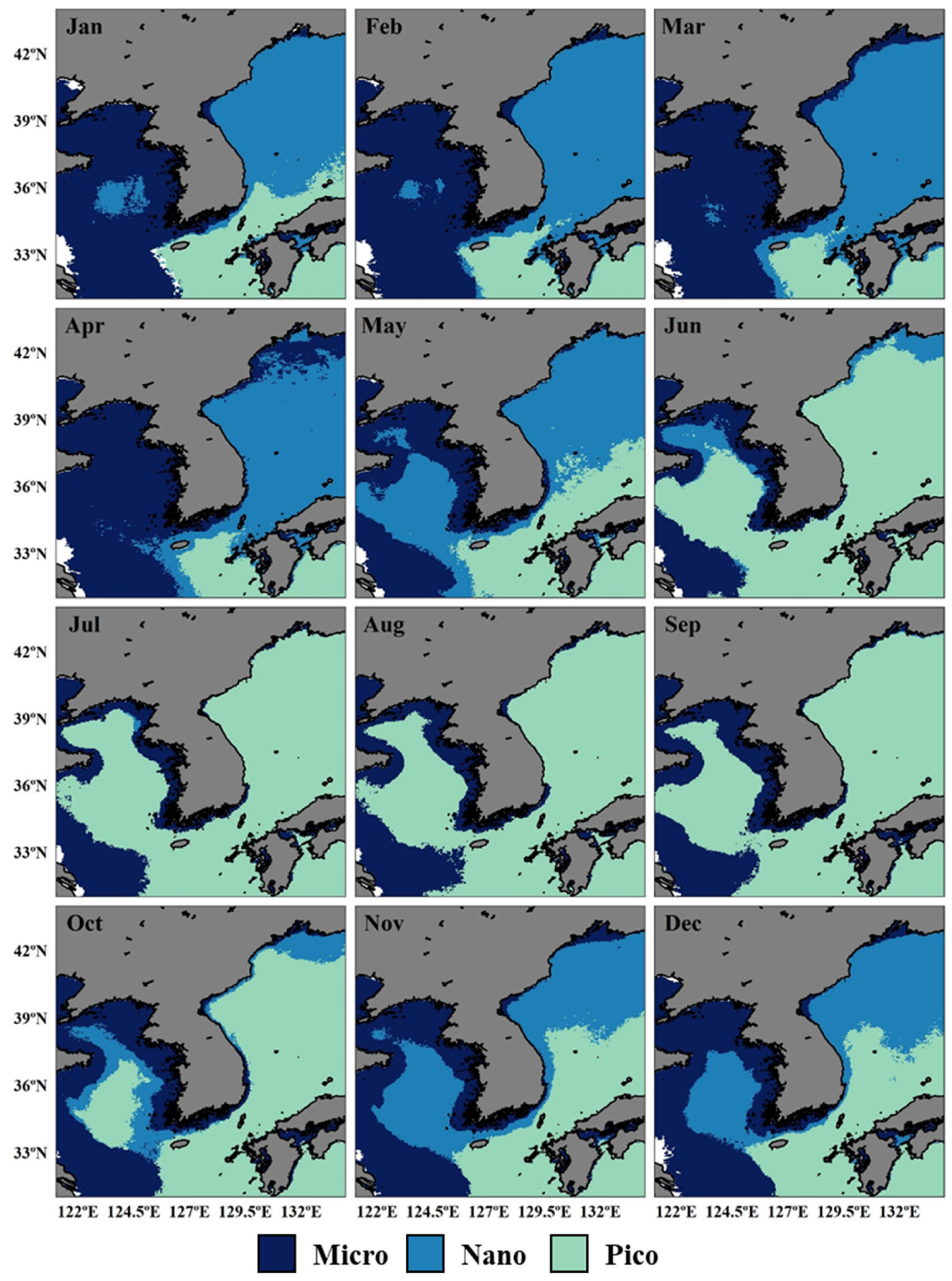
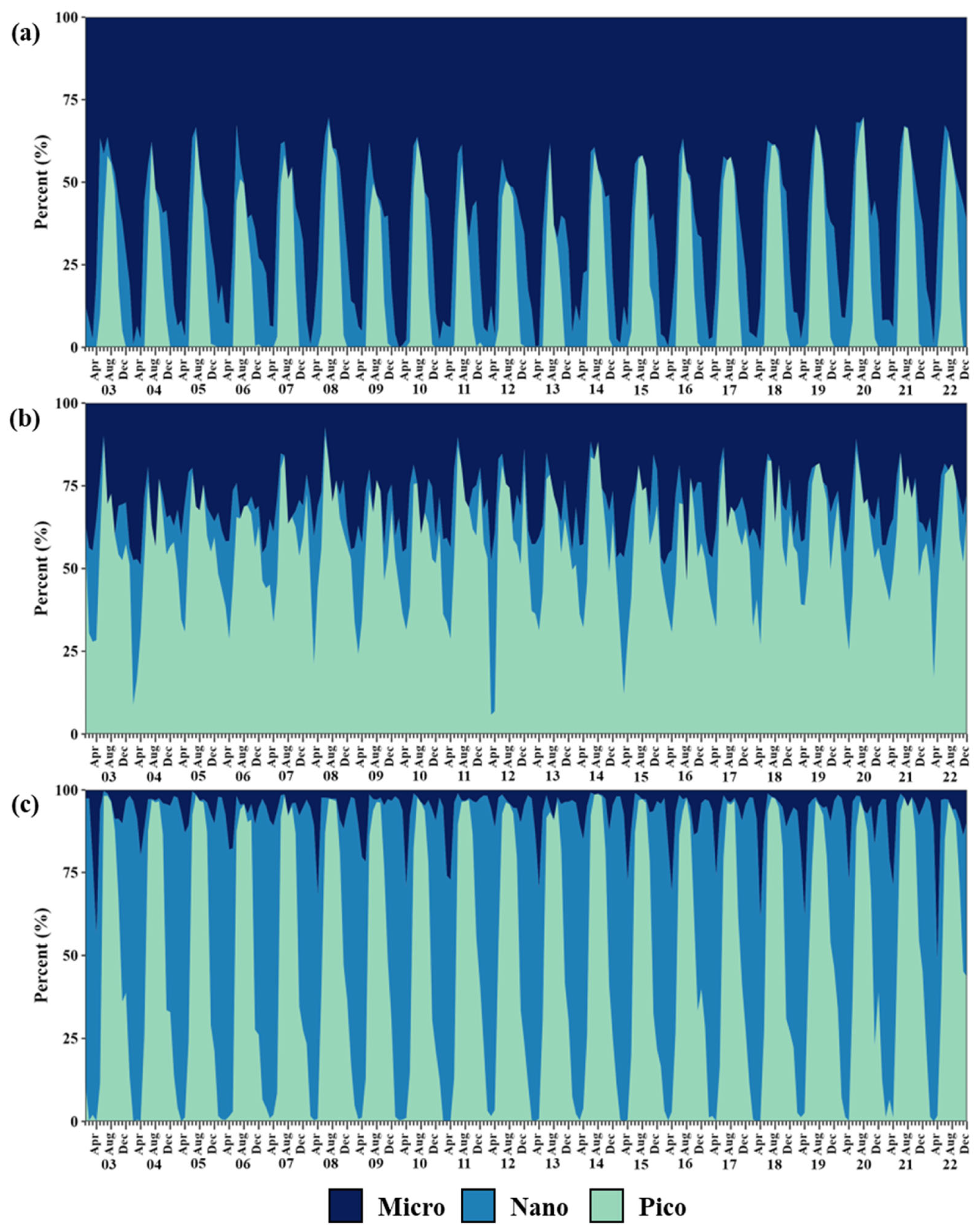
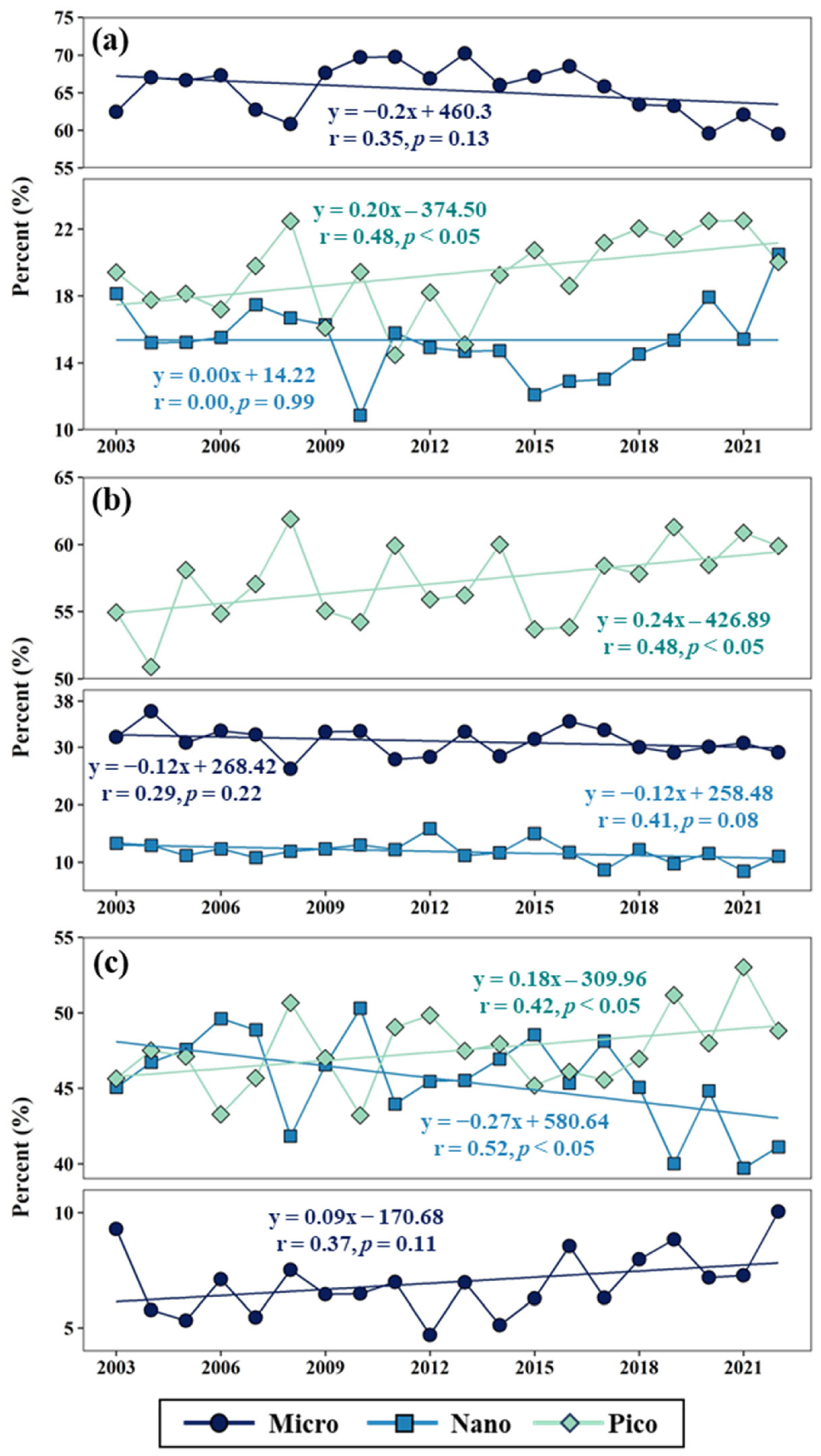
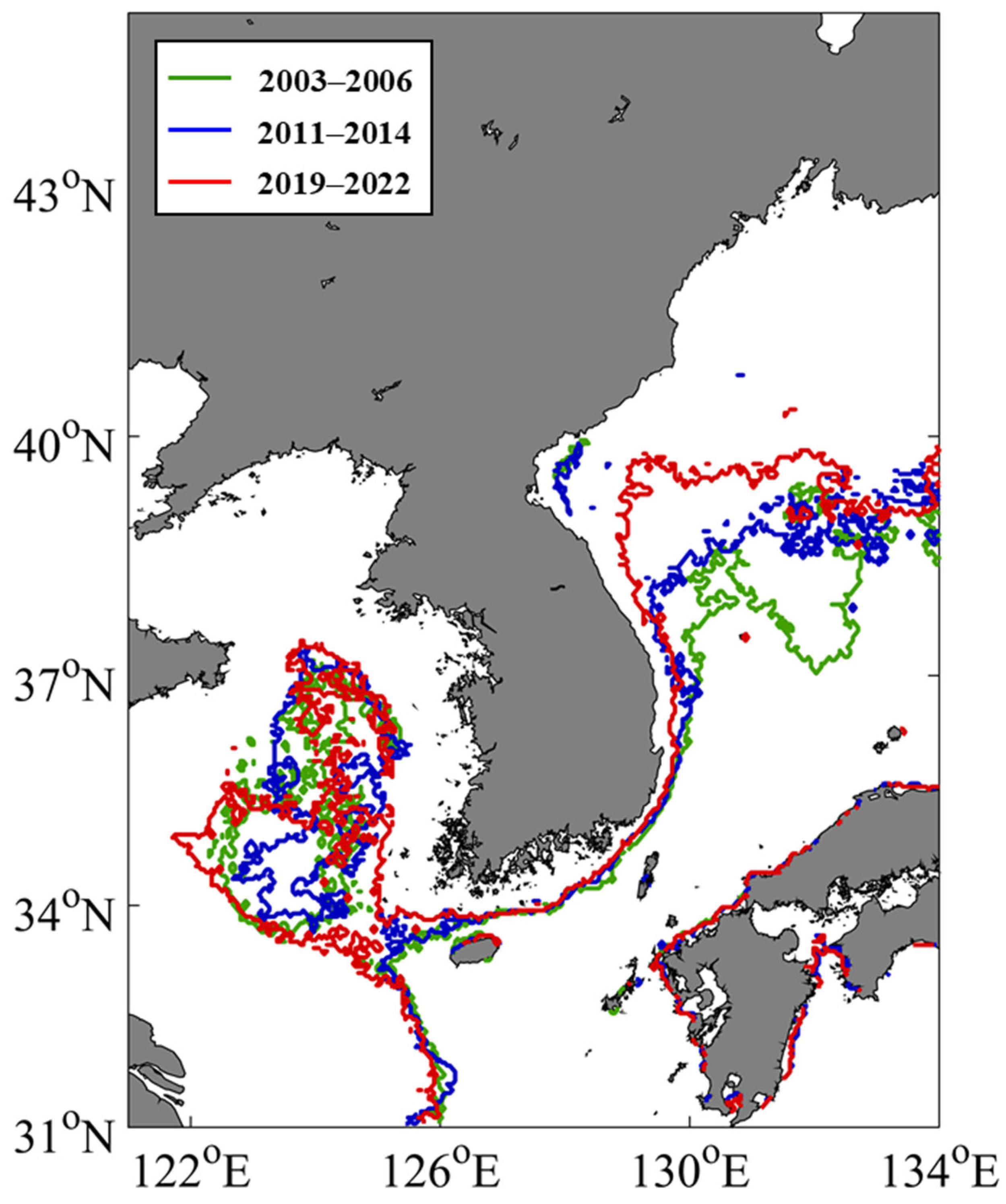


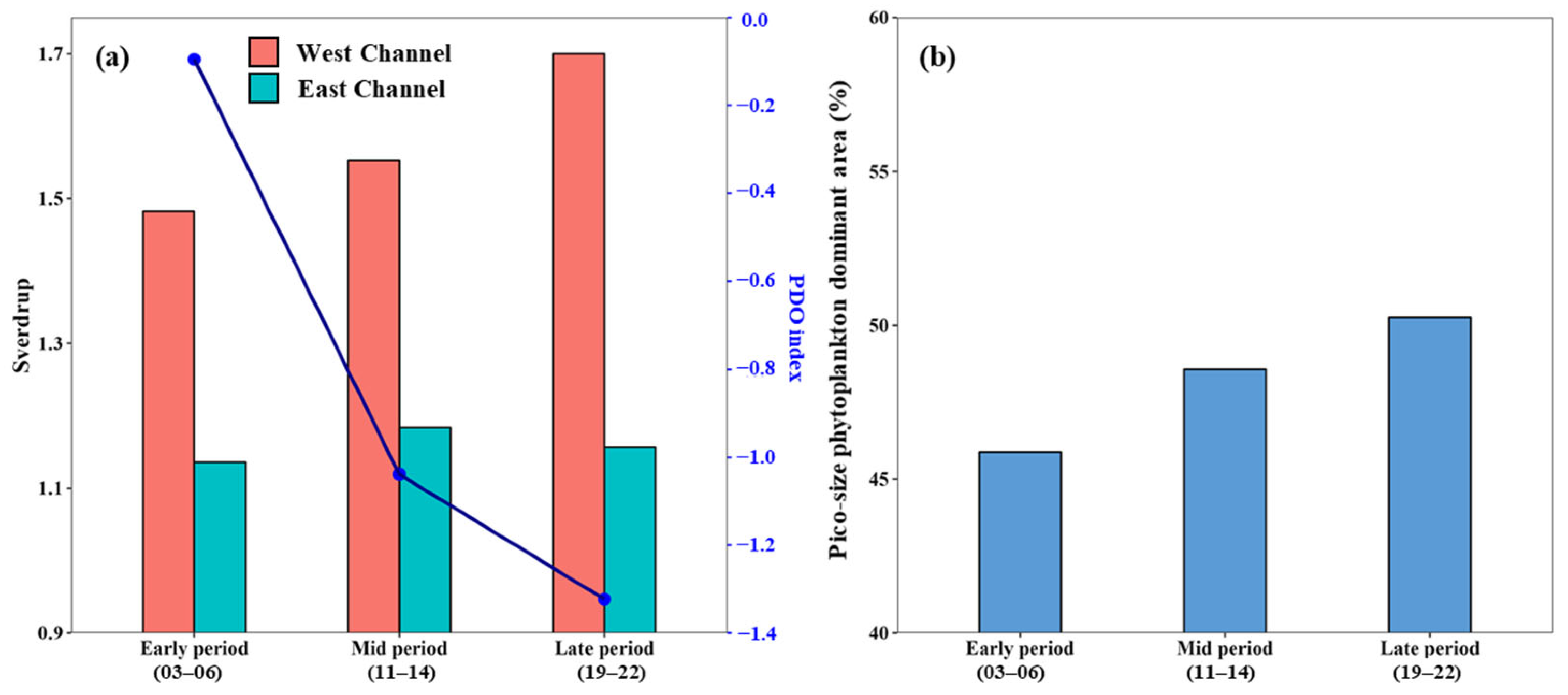
| Region | Season | Micro | Nano | Pico |
|---|---|---|---|---|
| YS | Winter | 84.2 (11.2) | 15.7 (11.1) | 0.0 (0.2) |
| Spring | 80.4 (17.9) | 18.3 (16.2) | 1.2 (3.5) | |
| Summer | 41.0 (6.6) | 6.5 (8.3) | 52.6 (9.5) | |
| Autumn | 55.7 (7.0) | 20.9 (14.7) | 23.4 (19.4) | |
| SS | Winter | 35.5 (8.0) | 11.6 (7.9) | 53.0 (12.1) |
| Spring | 35.8 (9.0) | 25.8 (8.5) | 38.4 (13.9) | |
| Summer | 23.6 (9.2) | 1.5 (2.7) | 74.9 (8.6) | |
| Autumn | 29.1 (5.1) | 8.4 (7.2) | 62.5 (9.0) | |
| EJS | Winter | 3.7 (1.9) | 79.9 (15.0) | 16.5 (14.2) |
| Spring | 15.4 (11.3) | 75.3 (13.0) | 9.3 (14.0) | |
| Summer | 2.7 (1.7) | 3.8 (5.3) | 93.5 (4.9) | |
| Autumn | 6.1 (3.5) | 23.3 (22.6) | 70.5 (24.8) |
Disclaimer/Publisher’s Note: The statements, opinions and data contained in all publications are solely those of the individual author(s) and contributor(s) and not of MDPI and/or the editor(s). MDPI and/or the editor(s) disclaim responsibility for any injury to people or property resulting from any ideas, methods, instructions or products referred to in the content. |
© 2025 by the authors. Licensee MDPI, Basel, Switzerland. This article is an open access article distributed under the terms and conditions of the Creative Commons Attribution (CC BY) license (https://creativecommons.org/licenses/by/4.0/).
Share and Cite
Jang, H.-K.; Kim, C.; Youn, S.-H.; Kang, J.-J.; Jung, H.; Joo, H. Long-Term Variability of Phytoplankton Size Classes in the Littoral Seas of Korea Using Deep Neural Networks and Satellite Data. J. Mar. Sci. Eng. 2025, 13, 1064. https://doi.org/10.3390/jmse13061064
Jang H-K, Kim C, Youn S-H, Kang J-J, Jung H, Joo H. Long-Term Variability of Phytoplankton Size Classes in the Littoral Seas of Korea Using Deep Neural Networks and Satellite Data. Journal of Marine Science and Engineering. 2025; 13(6):1064. https://doi.org/10.3390/jmse13061064
Chicago/Turabian StyleJang, Hyo-Keun, Changsin Kim, Seok-Hyun Youn, Jae-Joong Kang, Hwaeun Jung, and Huitae Joo. 2025. "Long-Term Variability of Phytoplankton Size Classes in the Littoral Seas of Korea Using Deep Neural Networks and Satellite Data" Journal of Marine Science and Engineering 13, no. 6: 1064. https://doi.org/10.3390/jmse13061064
APA StyleJang, H.-K., Kim, C., Youn, S.-H., Kang, J.-J., Jung, H., & Joo, H. (2025). Long-Term Variability of Phytoplankton Size Classes in the Littoral Seas of Korea Using Deep Neural Networks and Satellite Data. Journal of Marine Science and Engineering, 13(6), 1064. https://doi.org/10.3390/jmse13061064






